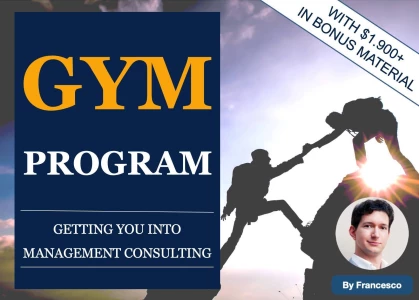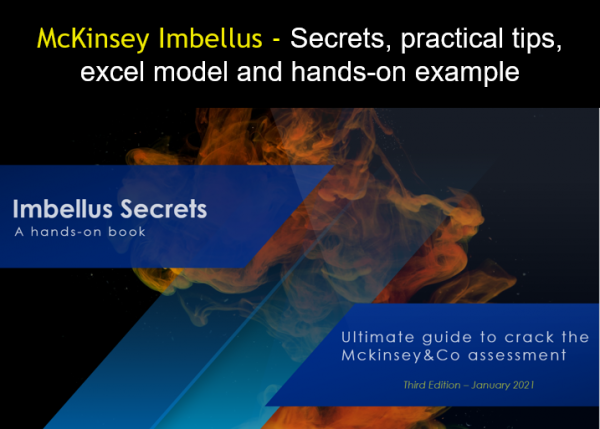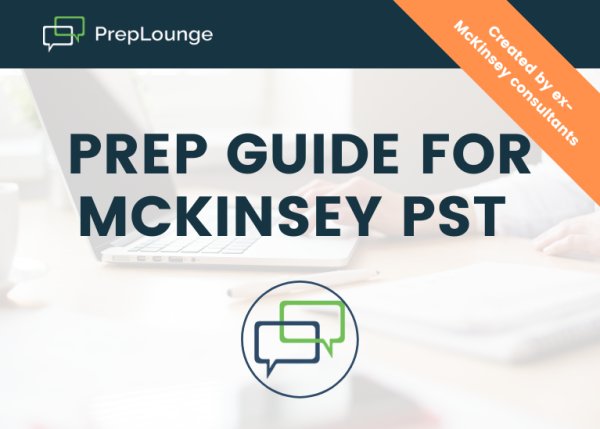Hi,
How do you approach CAGR calculations during the interview without excel?
Any tips?
Ex1: Your client revenue has grown from 100 to 150 in 5 years, how would you estimate the average annual growth manually (1,5)^(1/5)-1?
Thank you in advance!
Hi,
How do you approach CAGR calculations during the interview without excel?
Any tips?
Ex1: Your client revenue has grown from 100 to 150 in 5 years, how would you estimate the average annual growth manually (1,5)^(1/5)-1?
Thank you in advance!
Hi Anonymous,
basically here you have to compute
(1+x)^a=V
where you don’t know x and where a=5 and V=1,5.
For relative low interest rates and periods, the simpler process for precise results is the following:
1) Calculate what would be the solution with simple interest – in this case, 10%; the real result will always be lower than that
2) Decrease by 1 percentage point – in this case, 9%
3) Apply Taylor series till the third element. To do so, you would have to learn by heart the following formula:
1+ax+1/2*a*(a-1)*x^2
Given point 2, x=9%
1+0,45+1/2*5*4*0,09^2=
=1,45+10*0,0081=
=1,531
4) Repeat decreasing till when you find a value below V=1.5
Given x=8%
1+0,4+1/2*5*4*0,08^2=
=1,4+10*0,064=
=1,464
Thus the result is between 8% and 9%.
Hope this helps,
Francesco
(edited)
Hello,
You can use binomial appriximation but may have to iterate depending; works best with low value of r as noted below.
150/100 = (1+r)^5
Binomial approximation: means, set the right side to 1+ 5*r .... and ignore higher power terms in r for now..
Solving will give you r=0.1. Now this is equivanent to 10% simple ineterest. So compound rate will be smaller than 10%.
Also plug back and check how far off are we. (1.1)^5 = [(1.1*1.1)^2 ] *1.1 = (1.21^2) *1.1
~ 1.44*1.1 = 1.44+.14 = 1.58. Now 158 is pretty close to 150. You can stop here.
OR you can try 9% and see if that works. Now calculate 1.09^5 in bite size steps.
1.09^2 = 1+ 0.18+ 0.0081 ~1.19 ----- use (a+b)^2
Repeat again with (1.19)^2 = 1.38 + 0.19^2 ~ 1.38 + 0.04 ~ 1.40. ------ By now you have 1.09^4 approxiately
Last step 1.4*1.1 = 1.54.
So still higher than 1.5. Repeat with 8%
Regards,
SR
Easiest is the rule of 72 (if you divide 72 by the interest rate in question, you'll get the number of years it will take your money to double at that interest rate). So if interest rate were 12%, it'll take 5yrs to double 100 to 200. You are at 150 after 5 years, so, you know that it will take more than 5yrs to double, so the interest rate has to be <12%. At 6%, it'll take 12yrs to double, which means at year 6 it is at least 150, so 6% is too low. You can likely guess it's not exactly 9% because compound interest grows faster with each year, so you can estimate somewhere closer to 8%. If you practice more, you can get better at this.
Discover the secrets to Goal setting, Reality checking, Options exploring, and Way forward planning that will redefine your path to success.
Discover what McKinsey's 7S framework is and how it helps companies maximize their strengths and identify weaknesses while focusing on 7 internal elements.
Structured framework for sustainable corporate development, including market penetration, product development, market development and diversification.
Find out what the McKinsey Imbellus Game is all about. Get specific insights on how to ace your case interview at McKinsey.
The Influence Model by McKinsey emerged in the early 2000s and is the result of practical experience of the consultants at McKinsey & Company.













